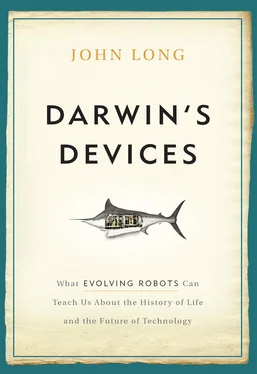Different models, then, serve different goals. Webb enumerates seven: emulating behavior and mechanism (both of which we’ve just seen) as well as abstractness, medium, generality, level, and, particularly important for us, whether or not the model tests a hypothesis—that is, an idea that you have about the biological system.
For Webb, if you are interested in any particular aspect of cats and you have learned as much from real cats as you can, then go ahead and model a cat. I think this would be Weiner’s position as well. But if your goal is to learn more about cats, Webb says, avoid the temptation to build something cool just for the sake of building it. There must be a specific target: you shouldn’t just try to build something cat-like. Her criticism is aimed at two fascinating fields, adaptive behavior and artificial life, in which many workers model invented animals, called animats. Although animats illuminate general operating and cognitive principles, Webb argues that the adaptive behavior and artificial life approaches do little to test specific hypotheses about how real animals work. For her, biologists building animats to test biological hypotheses usually walk away empty handed.
Webb’s critique of adaptive behavior and artificial life gets to the heart of my colleague’s skepticism. He intuited two of her points related to the value of any model to a biologist. First, your model must have a specific biological target. Second, your model must be relevant and must enable testing a hypothesis about the targeted system.
Of course, Webb’s critique also raises some problems for our response to the skeptics—that we should be able to use robots because robots are essentially computers. If computer models aren’t necessarily biologically relevant, then our robots may not be either. So our critique of the critiquer became this: he was asking the wrong question, or at least asking a sufficiently vague question to allow literalists like us to misunderstand. Instead of asking, “Why robots?” our skeptic ought to be asking, “What is the scientific purpose of your model, and why is your model in the form of a physically embodied robot?” But then there’s probably a question you’d like to ask of me: how did a biologist ever find himself sticking up for robots? The answer’s quite simple: it was for the love of fish.
FOR THE LOVE OF FISH
I’ve loved fish since I was a child, when I first saw Jacques Cousteau’s underwater world on television. I followed the wake of swimming fish and other aquatic vertebrates through college, graduate school, and, now, into a career. And there was a lot to learn in the flesh. With Steve Wainwright of Duke University and Mark Westneat of the Field Museum, I’ve scuba dived to videotape the propulsive oscillation of two hundred–pound blue marlin. With Mark, Melina Hale of the University of Chicago, and Matt McHenry of the University of California, I’ve outfitted rainbow trout, bowfin, longnose gar, and African bichir with tiny instruments to measure muscle function during escape maneuvers. With Wyatt Korff of the Janelia Farm Research Campus, I’ve used high-speed video to investigate how Wyatt’s trained Amazonian arawana can propel themselves out of the water to catch food in midair. With Lena Koob-Emunds and Tom Koob, I’ve worked at the Mount Desert Biological Laboratory to study the biomechanics of slimy pink hagfish so that we can learn about swimming without a vertebral column. Finally, with Marianne Porter of the University of California, I’ve measured the mechanical properties of the backbones of dogfish sharks to see how skeletons transmit force.
I love real fish, and more than twenty years’ work has shown me much about their shape and structure, how they move, and how they evolved. But real fish only reveal some of their secrets. As with any science, we are limited by what we can and cannot observe and measure. Sometimes we lack an instrument or a technology. At other times we lack the right fish. Take, for example, the giant blue marlin. They die in captivity, so studying them in a lab was impossible. So we went blue-water diving not because we wanted to (it’s very expensive and dangerous work) but because we had no other choice. We had to film blue marlin from a distance and leave some of our questions unanswered.
Well, not entirely. We could’ve studied marlin in other ways, but other questions would’ve been left unanswered. Say you want to know what’s going on inside a blue marlin when it swims. You could, as Barbara Block of Stanford University did, build a team of engineers and physiologists to design tiny instruments that can be implanted quickly in a marlin that you’ve brought alongside a boat using hook and line. These instrument tags carry their own computer, power pack, and broadcast system, collecting data and sending signals back to a ship or satellite. Block can measure the marlin’s body temperature, muscle activity, speed, and depth as it moves freely about its oceanic cabin.
But for all Block’s approach reveals about physiology, the method reveals nothing about the biomechanics of marlin backbones—and that’s what I wanted to study. The backbone, or vertebral column, runs from an animal’s head to tail, and its presence is one of the signatures of the vertebrates, a group of animals to which amphibians, birds, fish, mammals, and reptiles—some fifty-eight thousand species—all belong. In a fish the backbone prevents the body from shortening while also allowing it to bend, and it gives the whole body important mechanical features, such as the ability to store and release energy elastically like a spring. My pursuit of this question is what would ultimately send me headlong into the world of artificial intelligence and robots.
FROM THE FIELD TO THE LAB
I first met Block—and the blue marlin—back in 1986, when she, as a newly minted PhD from Knut Schmidt-Neilsen’s lab at Duke University, convinced me, a newbie PhD wannabe in Steve Wainwright’s lab, to work on the biomechanics of marlin vertebral columns in the laboratory. Under the guise of buying me a cup of coffee at the Ninth Street Bakery, Block pulled me out of the lab my first day so she could expound the virtues of the marlin.
Of all the fish, she explained in the car, marlin are the best, the fastest, biggest, coolest predators in the sea. “Think tuna are fast?” she asked rhetorically as we pulled into the parking lot. “Well, marlin eat tuna!” As we walked across the street to the bakery, she went for the kill. “Have you seen the vertebral column of a marlin?” she asked, sounding like a minister in the First Church of Poseidon. I knew the proper response: “No, I have not seen the vertebral column of a marlin. What does it look like?”
She introduced me to the mysteries of the marlin’s backbone. “It’s not like a bunch of little bones linked together, like pearls on string, that you see in regular bony fish,” she said. “The vertebral column of a marlin looks like a piece of wood, a long pine board, a one-by-six, with bones overlapping, bones welded together with collagenous connective tissue to form a single, giant spring.” She paused for effect. “And this spring works to store and release energy, the energy that powers the high speeds and spectacular leaps of marlin.”
I shuffled forward in the line, unable to muster words. Only images came to mind: marlin leaping and spinning above white caps, and terrified tuna, swimming for their lives but unable to avoid the explosive charges of the spring-loaded marlin. Block waited for a moment, paid for our coffee and muffins, and guided me to a table. Signaling with her hand for me to eat something, she gave me a chance to return from my reverie. Then she said, knowing the answer, “So. Are you in?” I gushed, “Absolutely!”
Читать дальше












